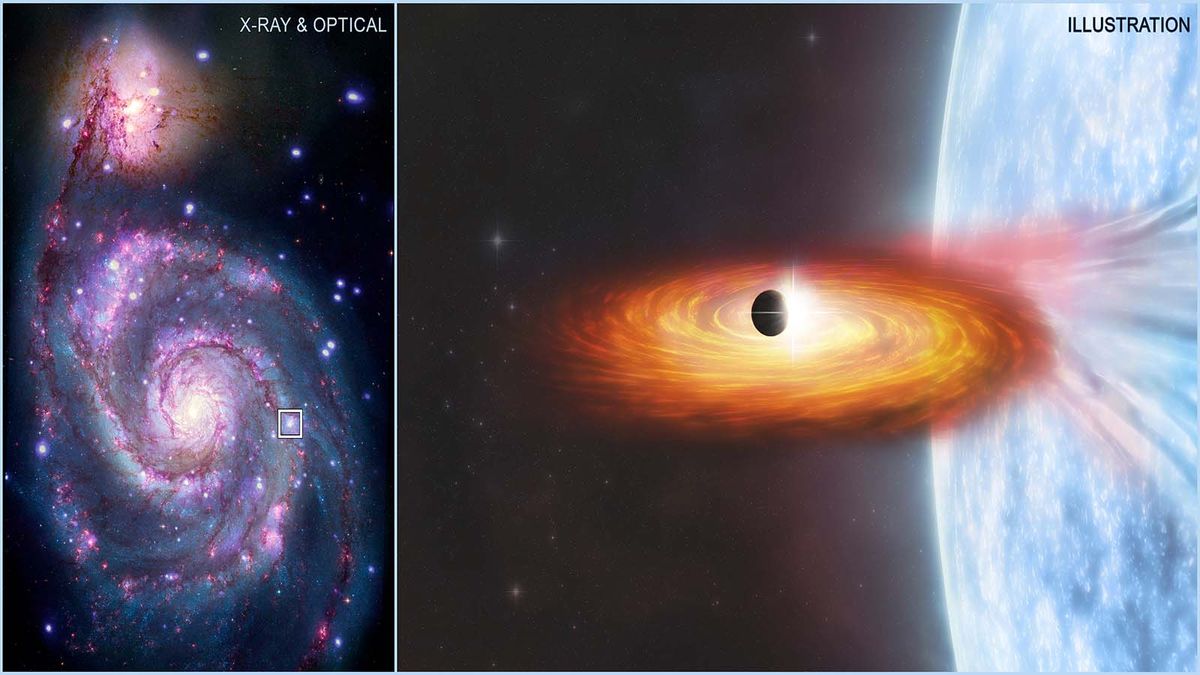
For those interested in space science — or even science fiction — astronomers have been full of fascinating news in the past few years. As technology improves, researchers have been able to discover even more celestial objects than we ever imagined, from comets and asteroids zipping through our solar system to dark matter and planets orbiting distant stars.
Now, we have evidence of planets far beyond those we've ever discovered before. But all the planets we've found through our advanced technology have been within our own Milky Way galaxy, until now that is.
In a paper published Oct. 25, 2021, in the journal Nature Astronomy, a team of astronomers and astrophysicists has put forth a new planetary candidate farther away than we've ever seen before. It's called M51-ULS-1b and is located in Messier 51, also called the Whirlpool Galaxy. While humans might never see — or even confirm — the existence of M51-ULS-1b, even its theoretical reality paves the way for more discoveries in the deep reaches of space beyond anything discovered before.
How We Find Planets
For decades, researchers have used data from Earth-based and space telescopes to find planets beyond those in our solar system, called exoplanets. Typically researchers look for a "transit" event, when the planet's orbit takes it in front of its star, from our perspective. Transits occur in our solar system too; you might recall one of the most recent transits occurred in 2019 when tiny Mercury passed in front of the sun.
Depending on the size of the planet relative to the star, a transit event will cause the star's brightness to dim — even when the star doesn't emit light along the visible wavelength; that's why the Chandra X-ray Observatory was used to discover this new planetary candidate.
In many cases, researchers are able to observe the star dimming and surmise that a planet must be orbiting that star (or stars, as there are circumbinary systems where a planet or planets orbit two stars!). These planetary candidates are put forward to the scientific community to verify with additional data, and have resulted in more than 4,000 confirmed exoplanets. Up until this point, every proposed exoplanet has been located within a small region of our own galaxy, the Milky Way.
Looking Outside the Milky Way
What makes this new paper compelling is the proposal that the researchers have a planetary candidate outside the Milky Way — way outside the Milky Way, in fact. According to their research, the astronomers and astrophysicists responsible for the discovery of M51-ULS-1b estimate it is some 28 million light-years from Earth.
Researchers chose to look outside our galactic neighborhood for two reasons. First, there's a better probability of discovering a planetary candidate using an X-ray transit technique, since X-ray sources occupy a smaller physical space and are thus more likely to be fully obscured in a transit.
"Dr. Di Stefano and Dr. Imara initially proposed to search for X-ray sources with several goals in mind," says Theron Carmichael, one of the paper's authors, speaking on behalf of the team. "One of which was to search for potential planet-hosting X-ray binaries because these binaries are physically small enough such that a planet could completely eclipse their X-ray signals."
The second reason was practical: The team had access to use the Chandra X-ray Observatory at a time when the observatory was pointed at an area of space where there were lots of data points. "The focus outside of the Milky Way was due to the number of X-ray sources within the field of view of the Chandra Observatory," Carmichael explains. "This made things more convenient to observe by allowing for a focus on one area of the sky and not having to point the telescope in very different locations in the sky."
While there are certainly X-ray sources within the Milky Way galaxy, "as of now, we're not aware of any new exoplanet candidates that orbit X-ray sources in the Milky Way," Carmichael says. "This technique is certainly applicable to X-ray sources within the Milky Way." And perhaps now, scientists will be inspired to look when their turn comes up on Chandra.
Verifying This Planetary Candidate
Unfortunately, due to this planet's tremendous distance from Earth and unique system composition, it's going to take a long time to verify whether M51-ULS-1b is actually there. Specifically, M51-ULS-1b orbits two stars: a neutron star or black hole (astronomers aren't sure exactly which) that's emitting the X-rays observed dimming during the transit, and a companion star that's 20 times the mass of our own sun.
The planetary candidate orbits both of these celestial objects — making it circumbinary — and takes roughly 70 years to make an orbit. So the next time a transit might be visible would be several decades from now.
"Since the next transit event is so uncertain (it could be as soon as decades from now, or much longer), there aren't any plans in place to take follow up observations of this particular planet candidate," Carmichael says. "Instead, new X-ray observations and archival data of previous observations are more readily available to search for more planet candidates like this one."
So, while the existence of M51-ULS-1b might never be verified, researchers plan to use it as inspiration to search for other planetary candidates like it far beyond the bounds of our galaxy, and perhaps even within it.
https://science.howstuffworks.com/first-planet-outside-milky-way-news.htm
2021-11-03 17:59:23Z
CBMiSWh0dHBzOi8vc2NpZW5jZS5ob3dzdHVmZndvcmtzLmNvbS9maXJzdC1wbGFuZXQtb3V0c2lkZS1taWxreS13YXktbmV3cy5odG3SAQA
Bagikan Berita Ini















0 Response to "Researchers Find First (Potential) Planet Outside the Milky Way - HowStuffWorks"
Post a Comment